change time Oldsmobile Achieva 1998 s User Guide
[x] Cancel search | Manufacturer: OLDSMOBILE, Model Year: 1998, Model line: Achieva, Model: Oldsmobile Achieva 1998Pages: 356, PDF Size: 18.04 MB
Page 159 of 356
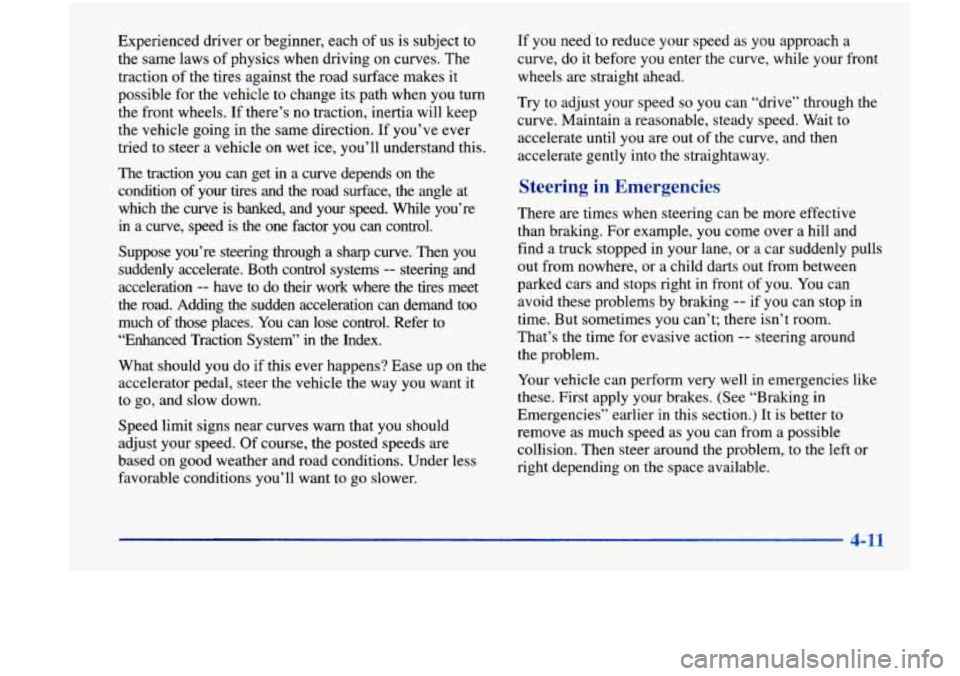
Experienced driver or beginner, each of us is subject to
the same laws of physics when driving on curves. The
traction of the tires against the road surface makes it
possible for the vehicle to change its path when you
turn
the front wheels. If there’s no traction, inertia will keep
the vehicle going in the same direction. If you’ve ever
tried to steer a vehicle on
wet ice, you’ll understand this.
The traction you can get in a curve depends on the
condition of your tires and the road surface, the angle at
which the curve is banked, and your speed. While you’re
in a curve, speed is the one factor you can control.
Suppose you’re steering through a sharp curve. Then you
suddenly accelerate. Both control systems
-- steering and
acceleration
-- have to do their work where the tires meet
the road. Adding the sudden acceleration can demand too much of those places. You can lose control. Refer to
“Enhanced Traction System” in the Index.
What should you do if this ever happens? Ease up on the
accelerator pedal, steer the vehicle the way you want it
to go, and slow down.
Speed limit signs near curves warn that you should
adjust your speed. Of course, the posted speeds are
based on good weather and road conditions. Under less
favorable conditions you’ll want to go slower. If you need to
reduce your speed as you approach a
curve, do it before you enter the curve, while your front
wheels are straight ahead.
Try to adjust your speed
so you can “drive” through the
curve. Maintain a reasonable, steady speed. Wait to
accelerate until you are out of the curve, and then
accelerate gently into the straightaway.
Steering in Emergencies
There are times when steering can be more effective
than braking. For example, you come over a hill and
find a truck stopped in your lane, or a car suddenly pulls
out from nowhere, or a child darts out from between
parked cars and stops right in front of you. You can
avoid these problems by braking
-- if you can stop in
time. But sometimes you can’t; there isn’t room.
That’s the time for evasive action
-- steering around
the problem.
Your vehicle can perform very well in emergencies like
these. First apply your brakes. (See “Braking in
Emergencies” earlier
in this section.) It is better to
remove as much speed as you can from a possible
collision. Then steer around
the problem, to the left or
right depending on the space available.
4-11
Page 162 of 356
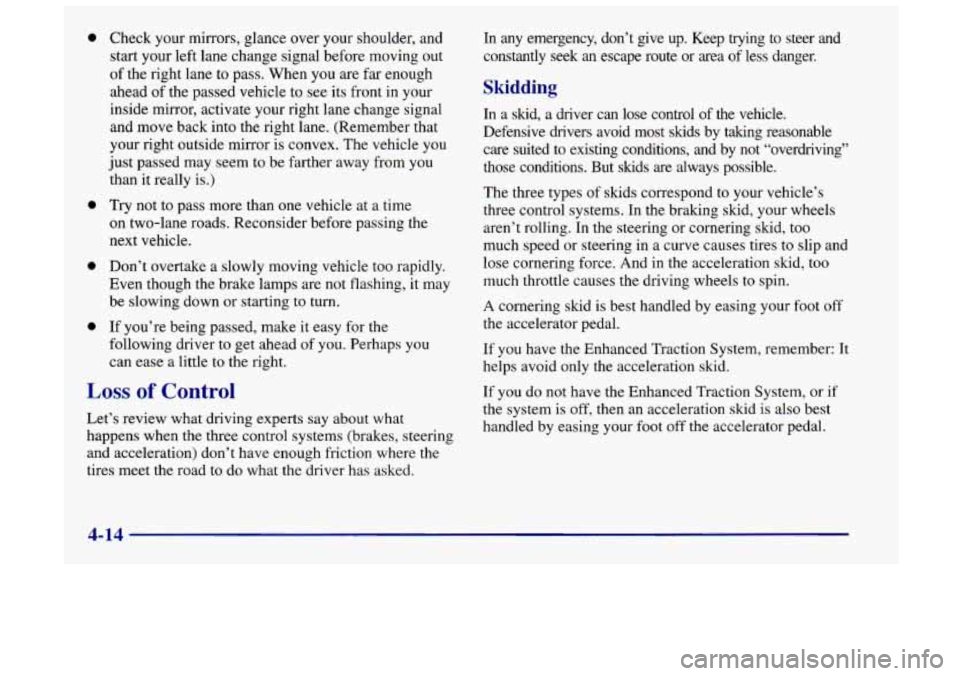
a
a
a
a
Check your mirrors, glance over your shoulder, and
start your left lane change signal before moving out
of the right lane to pass. When you are far enough
ahead of the passed vehicle to see its front in your
inside mirror, activate your right lane change signal
and move back into the right lane. (Remember that
your right outside mirror is convex. The vehicle you
just passed may seem to be farther away from you
than it really is.)
Try not to pass more than one vehicle at a time
on two-lane roads. Reconsider before passing the
next vehicle.
Don’t overtake a slowly moving vehicle too rapidly.
Even though the brake lamps are not flashing, it may
be slowing down or starting to turn.
If you’re being passed, make it easy for the
following driver to get ahead of you. Perhaps you
can ease a little to the right.
Loss of Control
Let’s review what driving experts say about what
happens when the three control systems (brakes, steering
and acceleration) don’t have enough friction where the
tires meet the road to do what the driver has asked.
In any emergency, don’t give up. Keep trying to steer ana
constantly seek an escape route
or area of less danger.
Skidding
In a skid, a driver can lose control of the vehicle.
Defensive drivers avoid most skids by taking reasonable
care suited to existing conditions, and by not “overdriving”
those conditions. But skids are always possible.
The three types of skids correspond to your vehicle’s
three control systems. In the braking skid, your wheels
aren’t rolling. In the steering or cornering skid, too
much speed or steering in a curve causes tires to slip and
lose cornering force. And in the acceleration skid, too
much throttle causes the driving wheels to spin.
A cornering skid is best handled by easing your foot off
the accelerator pedal.
If you have the Enhanced Traction System, remember: It
helps avoid only the acceleration skid.
If you do not have the Enhanced Traction System, or if
the system is off, then an acceleration skid is also best
handled by easing your foot off the accelerator pedal.
4-14
Page 181 of 356
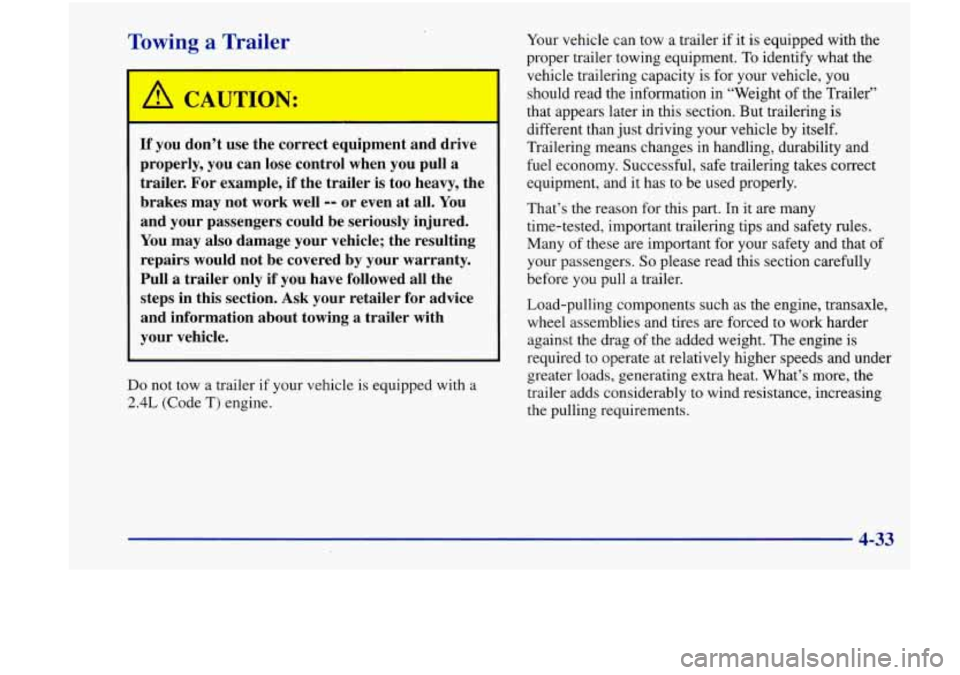
Towing a Trailer
L
If you don’t use the correct equipment and drive
properly, you can lose control when you pull a
trailer.
For example, if the trailer is too heavy, the
brakes may not work well
-- or even at all. You
and your passengers could be seriously injured.
You may also damage your vehicle; the resulting
repairs would not be covered by your warranty.
Pull
a trailer only if you have followed all the
steps in this section. Ask your retailer for advice
and information about towing a trailer with
your vehicle.
Do not tow a trailer if your vehicle is equipped with a
2.4L (Code T) engine. Your
vehicle can tow a trailer if it is equipped with the
proper trailer towing equipment.
To identify what the
vehicle trailering capacity is for your vehicle, you
should read the information in “Weight of the Trailer”
that appears later in this section. But trailering
is
different than just driving your vehicle by itself.
Trailering means changes in handling, durability and
fuel economy. Successful, safe trailering takes correct
equipment, and it has to be used properly.
That’s the reason for this part. In
it are many
time-tested, important trailering tips and safety rules.
Many of these are important for your safety and that
of
your passengers. So please read this section carefully
before you pull a trailer.
Load-pulling components such as the engine, transaxle,
wheel assemblies and tires are forced to work harder
against the drag of the added weight. The engine is
required to operate at relatively higher speeds and under
greater loads, generating extra heat. What’s more, the
trailer adds considerably to wind resistance, increasing
the pulling requirements.
4-33
Page 219 of 356

I'
I A CAUTION:
Rust or dirt on the wheel, or on the parts to
which it
is fastened, can make the wheel nuts
become loose after a time. The wheel could come
off and cause an accident. When you change a
wheel, remove any rust or dirt from the places
where the wheel attaches to the vehicle. In an
emergency, you can use
a cloth or a paper towel
to do
this; but be sure to use a scraper or wire
brush later,
if you need to, to get all the rust or
dirt off.
A CAUTION:
Never use oil or grease on studs or nuts. If you
do, the nuts might come loose. Your wheel could
fall off, causing
a serious accident.
9. Replace the wheel
nuts with the cone
end
of the nuts
toward the wheel.
Tighten each nut
by
hand or with the
wheel wrench until
the wheel
is held
against the hub.
5-31
Page 246 of 356
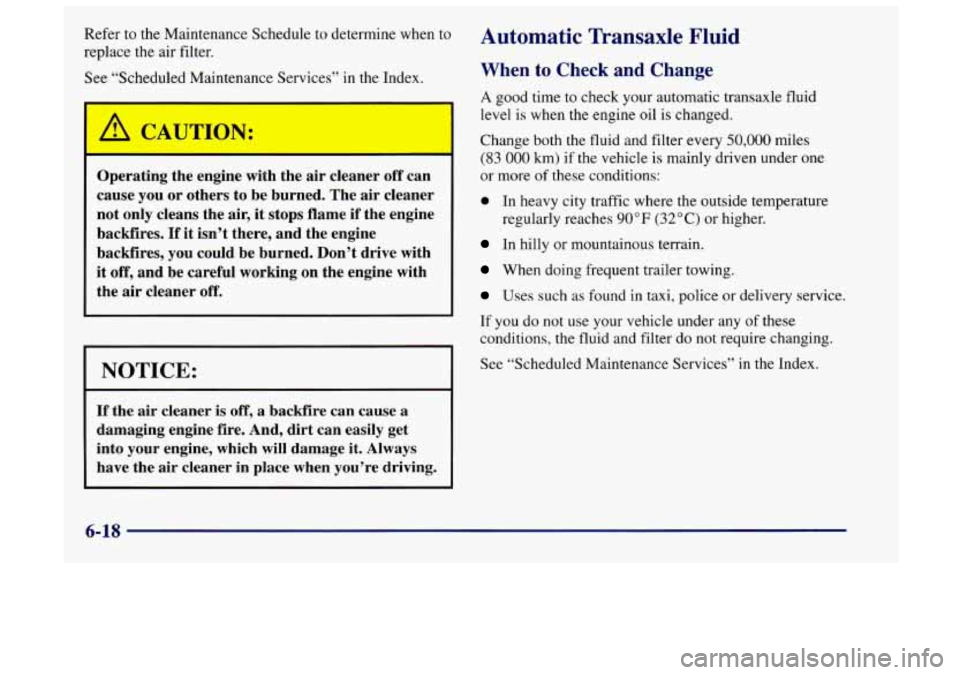
Refer to the Maintenance Schedule to determine when to
replace the air filter.
See “Scheduled Maintenance Services” in the Index.
Operating the engine with the air cleaner off can
cause you or others to be burned. The air cleaner
not only cleans the
air, it stops flame if the engine
backfires.
If it isn’t there, and the engine
backfires, you could be burned. Don’t drive with
it
off, and be careful working on the engine with
the air cleaner off.
I NOTICE:
If the air cleaner is off, a backfire can cause a
damaging engine fire. And, dirt can easily get
into your engine, which will damage it. Always
have the air cleaner in place when you’re driving.
Automatic Transaxle Fluid
When to Check and Change
A good time to check your automatic transaxle fluid
level is when the engine oil is changed.
Change both the fluid and filter every
50,000 miles
(83 000 km) if the vehicle is mainly driven under one
or more
of these conditions:
0 In heavy city traffic where the outside temperature
regularly reaches
90°F (32°C) or higher.
In hilly or mountainous terrain.
When doing frequent trailer towing.
Uses such as found in taxi, police or delivery service.
If you do not use your vehicle under any of these
conditions, the fluid and filter do not require changing.
See “Scheduled Maintenance Services”
in the Index.
6-18
Page 259 of 356

Replacing E ake Svstem Parts
The braking system on a modern vehicle is complex.
Its many parts have
to be of top quality and work well
together if the vehicle is to have really good braking.
Your vehicle was designed and tested with top-quality
GM brake parts. When
you replace parts of your braking
system
-- for example, when your brake linings wear
down and you have to have new ones put in
-- be sure
you get new approved GM replacement parts. If you
don’t, your brakes may no longer work properly. For
example, if someone puts in brake linings that
are wrong
for your vehicle, the balance between your front and
rear brakes can change
-- for the worse. The braking
performance you’ve come to expect can change in many
other ways if someone puts in the wrong replacement
brake parts.
Battery
Every new Oldsmobile has an AC Delco Freedom@
battery. You never have to add water to one of these.
When it’s time for a new battery, we recommend an
AC
Delco Freedom battery. Get one that has the replacement
number shown on the original battery’s label.
Vehicle Storage
If you’re not going to drive your vehicle for 25 days
or more, remove the black, negative
(-) cable from
the battery. This will help keep your battery from
running down.
Batteries have acid that can burn you and gas
that can explode.
You can be badly hurt if you
aren’t careful. See “Jump Starting” in the Index
for tips
on working around a battery without
getting hurt.
Contact your retailer to learn how to prepare your
vehicle for longer storage periods.
Also, for your audio system, see “Theft-Deterrent
Feature” in the Index.
6-31
Page 267 of 356

When It’s Time for New Tires Don’t include the compact spare tire in your
tire rotation.
After the tires have been rotated, adjust the front and
rear inflation pressures as shown on the Tire-Loading
Information label. Make certain that
all wheel nuts
are properly tightened. See “Wheel Nut Torque” in
the Index.
Rust or dirt on a wheel, or on the parts to which
it is fastened, can make wheel nuts become loose
after
a time. The wheel could come off and cause
an accident. When you change a wheel, remove
any rust or dirt from places where the wheel
attaches to the vehicle. In an emergency, you can
use a cloth
or a paper towel to do this; but be
sure to
use a scraper or wire brush later, if you
need to, to get
all the rust or dirt off. (See
“Changing
a Flat Tire” in the Index.)
One way to tell when it’s
time for new tires is to
check the treadwear
indicators, which will
appear when your tires have
only
1/16 inch (1.6 mm) or
less of tread remaining.
You need a new tire
if any of the following statements
are true:
You can see the indicators at three or more places
around the tire.
You can see cord or fabric showing through the
tire’s rubber.
0 The tread or sidewall is cracked, cut or snagged
The tire has a bump, bulge or split.
0 The tire has a puncture, cut or other damage that
deep
enough to show cord or fabric.
can’t be repaired well because of the size or location
of the damage.
6-39
Page 341 of 356
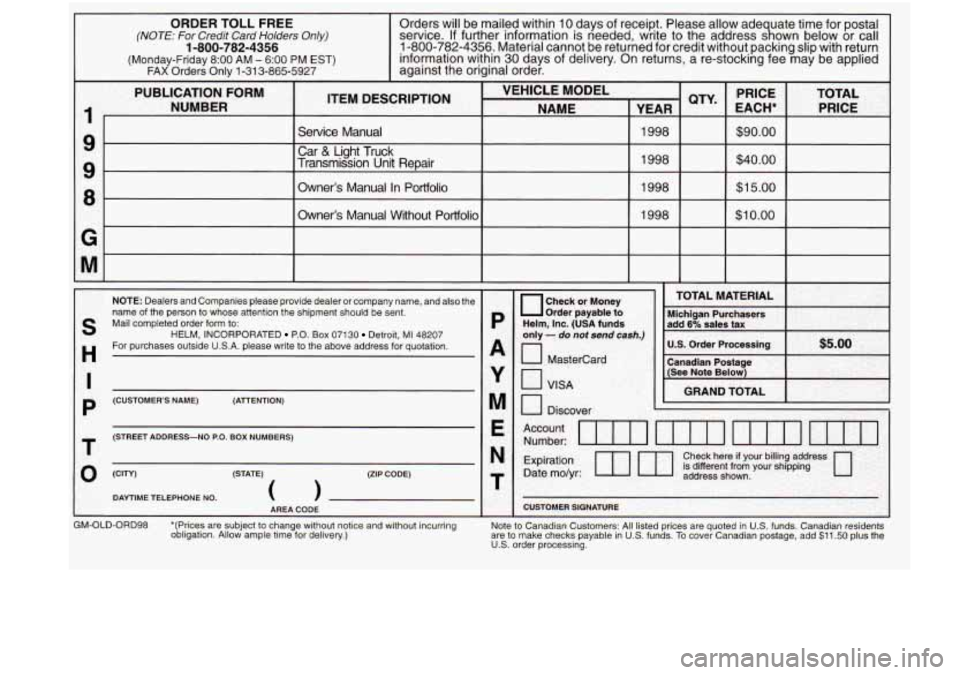
r
ORDER TOLL FREE Orders will be mailed within 1 O.days of receipt. Please allow ade uate time for postal
(NOTE: For Credit Card Holders Only) service. If further informatlon IS needed, write to the address s s, own below or call
(Monday-Friday 8:OO AM - 6:OO PM EST) information within 30 days of delivery. On returns, a re-stocking fee may be applied 1-800-782-4356 1-800-782-4356. Material cannot be returned for credit without p\
acking slip with return
FAX Orders Only 1-31 3-865-5927 against the original order.
PUBLICATION FORM
NUMBER
'I
9
9
a
S
H
I
P
T
0
NOTE: Dealers and Companies please provide dealer or company name, an\
d also the
name of the person to whose attention the shipment should be sent.
Mail completed order form to:
For purchases outside
USA. please write to the above address for quotation. HELM, INCORPORATED P.O. Box 07130 Detroit, MI 48207
(CUSTOMER'S NAME) (AlTENTION)
(STREET ADDRESS-NO P.O.
BOX NUMBERS)
(CITY) (STATE)
(ZIP CODE)
DAYTIME TELEPHONE NO.
0
AREA CODE
GM-OLD-ORD98 *(Prices are subject to change without notice and without incurring
obligation. Allow ample time for delivery.)
-
P
A
Y
M
E
N
T
-
Check or Money
Order payable to
Helm, Inc. (USA funds
only - do not send cash.)
[7 Mastercard
0 VISA
n
1
1
TOTAL MATERIAL
Michigan Purchasers
add 6% sales tax
Canadian Postage
U Discover I
Expiration rl m Check here if your billing address
Date molyr: is different from your shipping
address shown,
CUSTOMER SIGNATURE
Note to Canadian Customers: All listed prices are quoted in U.S. funds. Canadian residents
are to make checks payable in U.S. funds. To cover Canadian postage, add $1 1.50 plus the US. order processing.
Page 352 of 356

Tires (Continued)
Changing a Flat
.............................. 5-25
Compact Spare
............................... 5-36
Cleaning
.................................... 6-49
Inflation
.................................... 6-37
Inflation Check
............................... 7-30
Inspection and Rotation
........................ 6-38
Loading
.................................... 4-31
Pressure
.................................... 6-37
Temperature
................................. 6-42
Traction
.................................... 6-41
Treadwear
................................... 6-41
Uniform Quality Grading
....................... 6-41
Used Replacement Wheel
...................... 6-43
Wear Indicators
.............................. 6-39
Wheel Replacement
........................... 6-42
When It’s Time for New
....................... 6-39
TopStrap
..................................... 1-44
TorqueLock
................................... 2-25
Torque, Wheel Nut
......................... 5-33. 6-58
Towing
From the Front (Automatic Transaxle)
............ 4-29
From the Rear
............................... 4-30
Recreational Vehicle
.......................... 4-29
Towing a Trailer
................................ 4-33
Towing Your Vehicle
............................ 4-29
Towing Your Vehicle
............................. 5-8
Towing Your Vehicle From the Front
(Automatic Transaxle)
.......................... 4-29
Towing
Your Vehicle From the Rear ................ 4-30 Trailer
Backingup
................................. 4-37
Brakes
..................................... 4-36
Driving on Grades
............................ 4-38
Driving with a
............................... 4-37
Following Distance When Driving with a
.......... 4-37
Hitches
..................................... 4-36
Maintenance When Towing
..................... 4-40
Making Turns with a
.......................... 4-38
Parking on Hills
.............................. 4-39
Passing with a
............................... 4-37
Safety Chains
................................ 4-36
Tongueweight
............................... 4-35
Total Weight on Tires
.......................... 4-36
Towing
..................................... 4-33
Turnsignals
................................. 4-38
Weight
..................................... 4-34
Transaxle Automatic
.......................... 6-18
Transmitters. Remote Lock Control
.................. 2-6
Transportation. Courtesy
.......................... 8-6
Lock ....................................... 2-10
Release. Remote
.............................. 2-10
TTYUsers
..................................... 8-4
Turn Signal and Lane Change Signals
............... 2-30
Turn Signal On Chime
........................... 2-31
Turn Signalhlultifunction Lever
................... 2-30
Turn Signals When Towing a Trailer
................ 4-38
Underbody Flushing Service
..................... 7-33
Underbody Maintenance
......................... 6-50
9-10